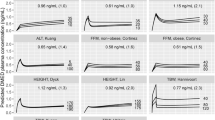Abstract
Objective. N2O is a commonly used anesthetic that has amnestic and analgesic properties. Recently, devices that estimate depth of consciousness have been introduced in an attempt to better titrate anesthesia, however the effect of N2O on these monitors is unclear. Methods. General anesthesia was induced and titrated to maintain normal blood pressure and pulse in healthy adults. Data were collected in three 10 minute intervals (Sevo, Sevo + N2O, Sevo). In Phase A, sevoflurane concentration was held constant during the N2O trial in 60 subjects monitored with either BIS, PSI, or Entropy. In Phase B, sevoflurane concentration was reduced as N2O was added, maintaining a constant overall “MAC” in 20 subjects monitored concurrently with BIS and Entropy. Sample size for both phases was designed to detect a 10 unit change in measure of processed EEG with alpha = .05 and statistical power = .80. Results. In Phase A, supplementing sevoflurane with > 65% N2O increased MAC from 1.3 ± 0.05 to 2.2 ± 0.10, but did not significantly alter BIS nor PSI (p-value for differential MAC is < 0.05). Entropy, however, dropped significantly, with a change in state entropy (SE) from 31.1 ± 7.3 to 18.9 ± 3.7 and a corresponding rise when N2O was discontinued. In Phase B, supplementing sevoflurane with > 65% N2O with a concomitant reduction in sevoflurane resulted in an increase in both BIS (from 34 ± 5 to 53.9 ± 11.5) and SE (from 32 ± 8.2 to 55.4 ± 21.3). Conclusion. Supplementing sevoflurane with > 65% N2O did not result in a significant change in either BIS or PSI when sevoflurane concentration was kept constant. Entropy, however, significantly decreased as anesthetic depth increased. When sevoflurane concentration was reduced during N2O administration, both BIS and Entropy rose despite maintenance of anesthetic depth, indicating a variable concentration effect between volatiles and N2O.
Similar content being viewed by others
References
Johansen J, Sebel P. Development and clinical application of electroencephalographic bispectrum monitoring. Anesthesiology 2000; 93: 1335–1344.
Prichep L, Gugino L, John E, Chabot R, Howard B, Merkin H, Tom M, Wolter S, Rausch L, Kox W. The Patient State Index as an indicator of the level of hypnosis under general anaesthesia. Br J Anaesth 2004; 92: 393–399.
Vakkuri A, Yli-Hankala A, Talja P, Mustola S, et al. Time-frequency balanced spectral entropy as a measure of anesthetic drug effect in central nervous system during sevoflurane, propofol, and thiopental anesthesia. Acta Anaesth Scand 2004; 48: 145–153.
Eger EI II, Saidman LJ, Brandstater B. Minimum alveolar anesthetic concentration: A standard of anesthetic potency. Anesthesiology 1965; 26: 756–763.
Rampil IJ, Mason P, Singh H. Anesthetic potency (MAC) is independent of forebrain structures in the rat. Anesthesiology 1993; 78: 707–712.
Sebel PS, Lang E, Rampil IJ, White PF, Cork R, Jopling M, Smith NT, Glass PSA, Manberg P. A Multicenter Study of Bispectral Electroencephalogram Analysis for Monitoring Anesthetic Effect. Anesthesia & Analgesia 1997; 84: 891–899.
Saidman L, Eger E. Effect of nitrous oxide and of narcotic premedication on the alveolar concentration of halothane required for anesthesia. Anesthesiology. 1964; 25: 302–306.
Torri G, Damia G, Fabiani M. Effect of nitrous oxide on the anaesthetic requirement of enflurane. Br J Anaesth 1974; 46: 468–472.
Stevens W, Dolan W, Gibbons R, White A, Eger E, Miller R, De Jong R, Elashoff .: Minimum alveolar concentrations (MAC) of isoflurane with and without nitrous oxide in patients of various ages. Anesthesiology 1975; 42: 197–200.
Rampil I, Kim J, Lenhardt R, Negishi C, Sessler D. Bispectral EEG index during nitrous oxide administration. Anesthesiology 1998; 89: 671–677.
Barr G, Jakobsson J, Owall A, Anderson R. Nitrous oxide does not alter bispectral index: Study with nitrous oxide as sole agent and as an adjunct to IV. anaesthesia. Br J Anaesth 1999; 82: 827–830.
Anderson R, Jakobsson J. Entropy of EEG during anaesthetic induction: A comparative study with propofol or nitrous oxide as sole agent. Br J Anaesth 2004; 92: 167–170.
Johansen J, Sebel P. Development and clinical application of electroencephalographic bispectrum monitoring. Anesthesiology 2000; 93: 1335–1344.
Vanluchene A, Vereecke H, Thas O, Mortier E, Shafer S, Struys M. Spectral entropy as an electroencephalographic measure of anesthetic drug effect: A comparison with bispectral index and processed midlatency auditory evoked response. Anesthesiology 2004; 101: 34–42.
Röpcke H, Lier H, Hoeft A, Schwilden H. Isoflurane, nitrous oxide, and fentanyl pharmacodynamic interactions in surgical patients as measured by effects on median power frequency. J Clin Anesth 1999; 11: 555–562.
Röpcke H, Schwilden H, Interaction of isoflurane and nitrous oxide combinations similar for median electroencephalographic frequency and clinical anesthesia. Anesthesiology 1996; 84: 782–788.
Röpcke H, Wirz S, Bouillon T, Bruhn J, Hoeft A. Pharmacodynamic interaction of nitrous oxide with sevoflurane, desflurane, isoflurane, and enflurane in surgical patients: Measurements by effects on EEG median power frequency. Eur J Anesth 2001; 18: 440–449.
Bruhn J, Ropcke H, Hoeft A. Approximate entropy as an electroencephalographic measure of anesthetic drug effect during desflurane anesthesia. Anesthesiology 2000; 92: 715–726.
Rampil I, Laster M. No correlation between quantitative electroencephalographic measurements and movement response to noxious stimuli during isoflurane anesthesia in rats. Anesthesiology 1992; 77: 920–925.
Hans P, Dewandre P, Brichant J, Bonhomme V. Effects of nitrous oxide on spectral entropy of the EEG during surgery under balanced anaesthesia with sufentanil and sevoflurane. Acta Anaesthesiol Belg 2005; 56: 37–43.
Author information
Authors and Affiliations
Corresponding author
Rights and permissions
About this article
Cite this article
Soto, R.G., Smith, R.A., Zaccaria, A.L. et al. The effect of addition of nitrous oxide to a sevoflurane anesthetic on BIS, PSI, and entropy. J Clin Monit Comput 20, 145–150 (2006). https://doi.org/10.1007/s10877-006-9009-0
Received:
Accepted:
Published:
Issue Date:
DOI: https://doi.org/10.1007/s10877-006-9009-0




